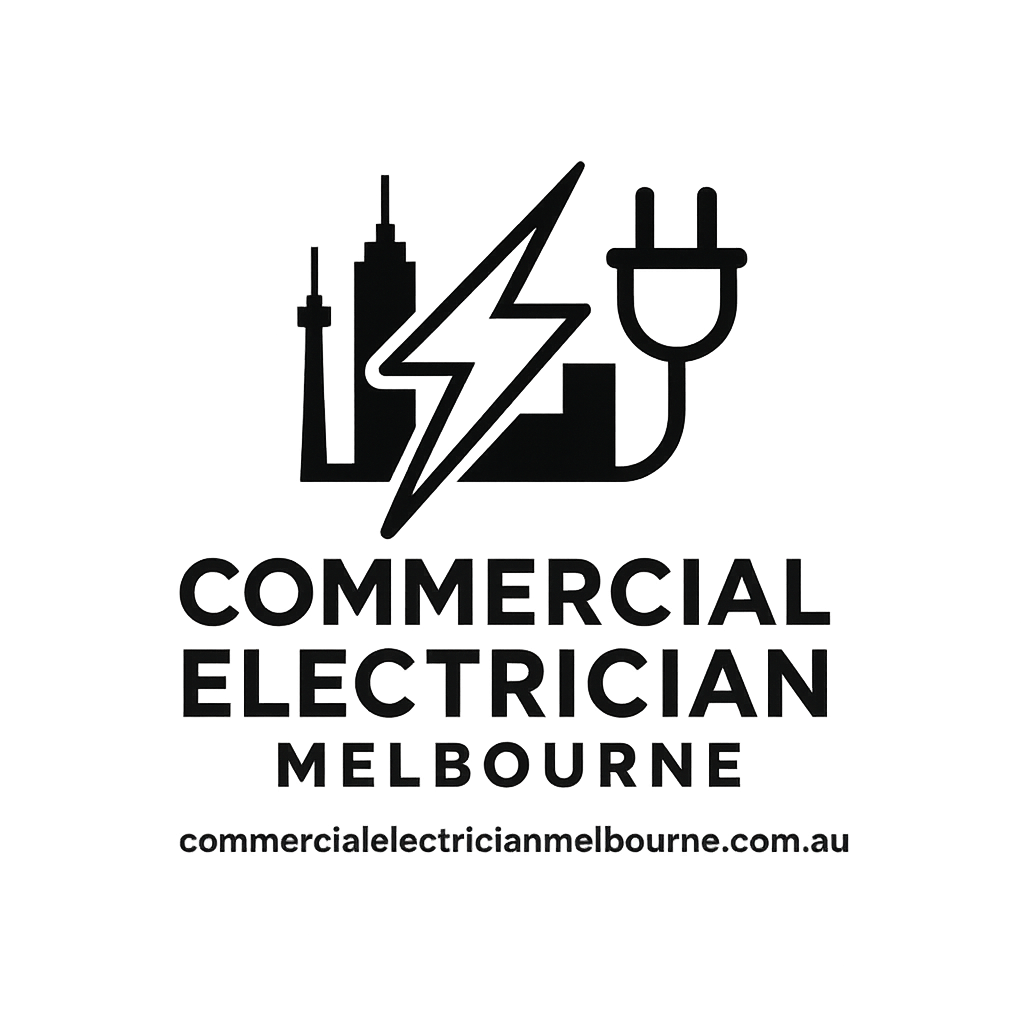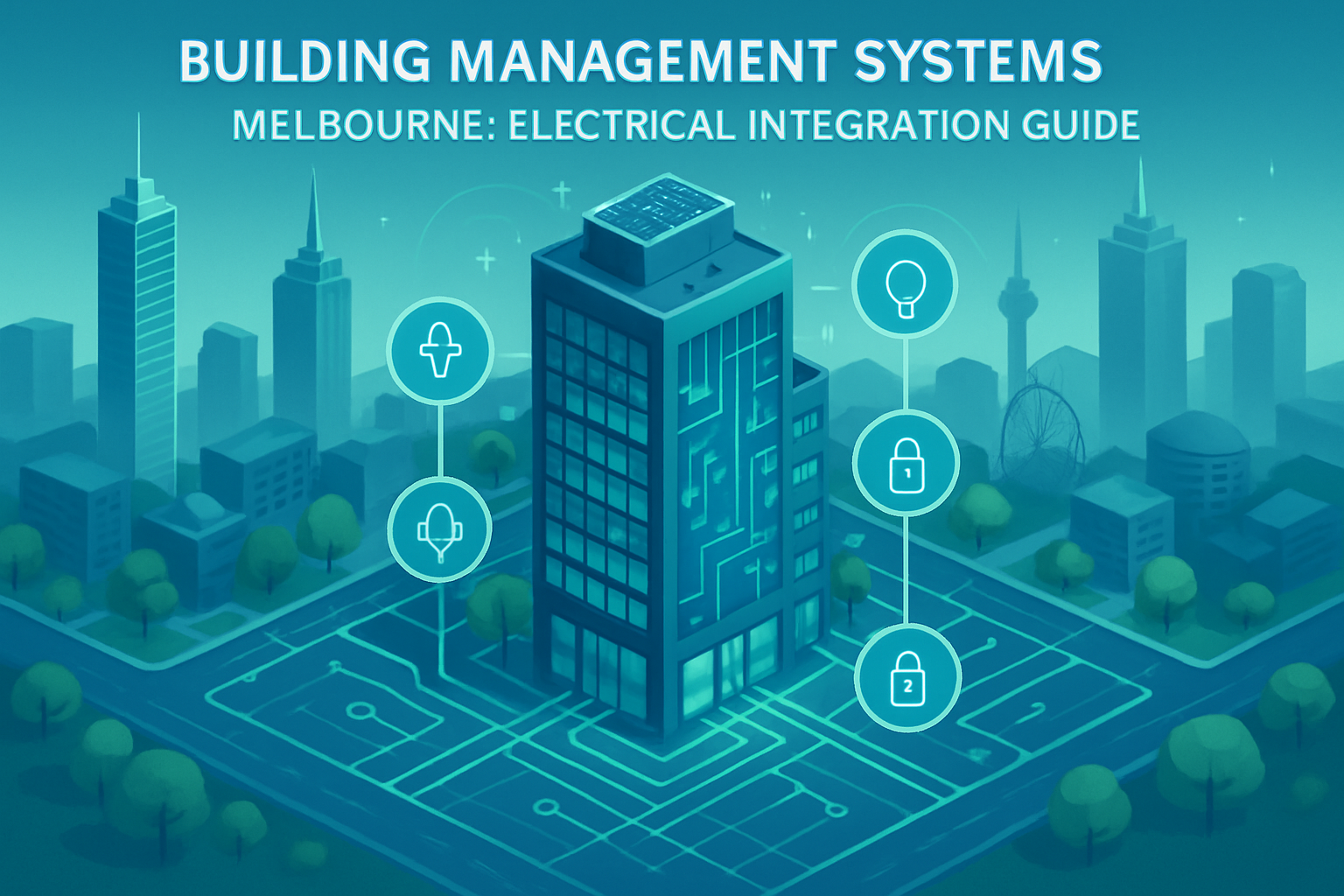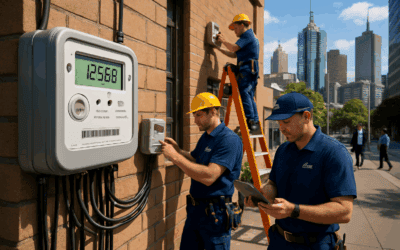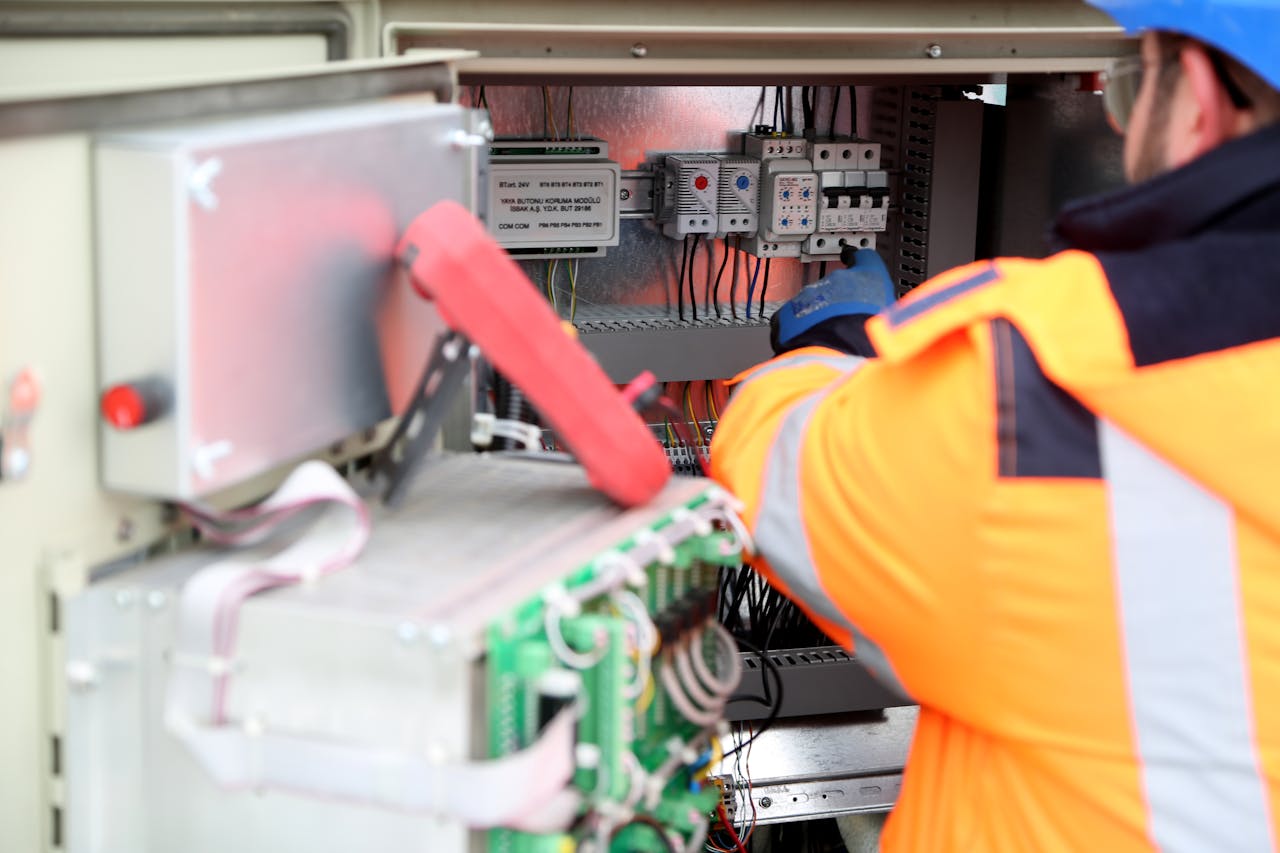What Is a Building Management System (BMS)?
Why Are Building Management Systems Important for Your Business?
Key Features and Benefits of Modern BMS
Understanding the Electrical Integration in a BMS
Steps to Find the Right Commercial Electrician in Melbourne
Preparing for a BMS Installation: Practical Tips
Local Regulations, Codes, and Best Practices in Melbourne
Future Trends in Building Automation Systems
Case Studies: Success Stories in Commercial Building Automation
Running a small business in Melbourne means juggling a lot of responsibilities—from maintaining customer relationships to ensuring your building runs smoothly. One major area you might not have thought about until recently is your building’s electrical systems. With commercial properties becoming smarter and more energy-efficient, understanding Building Management Systems (BMS) is a must. In this guide, we’re diving deep into the world of building automation systems in Melbourne, covering everything from energy management systems to HVAC control systems. If you’re looking to make your commercial property more efficient and safe, read on!
Introduction
In today’s fast-paced environment, small business owners must keep an eye on operational efficiency and cost-effectiveness. With increasing energy bills and safety concerns, managing and monitoring your building’s electrical systems is more critical than ever. A Building Management System (BMS) provides the technological boost to oversee and control various subsystems such as HVAC, lighting, security, and energy management. But it isn’t just about having a tech upgrade; it’s about improving your bottom line, increasing safety, and future-proofing your property.
For many business owners in Melbourne, the thought of overhauling electrical systems can be daunting. However, modern smart building controls and integrated building solutions are designed to grow with your business, ensuring you don’t end up with obsolete technology. This article will walk you through the essentials of building management systems, the benefits for your commercial property, tips to select a reliable commercial electrician, and the local regulations you need to follow. Whether you’re in the middle of a BMS installation in Melbourne or planning an upgrade soon, this guide is tailored just for you.
What Is a Building Management System (BMS)?
A Building Management System, or BMS, is a centralized system that monitors, controls, and manages a facility’s mechanical and electrical equipment. This can include systems such as:
- HVAC (Heating, Ventilation, and Air Conditioning)
- Lighting and electrical distribution
- Security systems
- Energy management and monitoring
- Fire safety systems
At its core, a BMS collects real-time data and feeds it into intelligent software that automates, optimizes, and monitors day-to-day building operations. In a commercial property context, this means that you can run your building more efficiently with reduced energy costs, and improve both occupant comfort and safety. In Melbourne, where weather extremes and energy prices are a real concern, these systems can be a game changer.
A Quick Look at BMS Components
- Sensors and Actuators: Detect and respond to changes in temperature, light levels, occupancy, or energy consumption.
- Controllers: Direct the operations of the building’s systems by connecting various subsystems.
- User Interfaces: Dashboards that allow facility managers to view real-time data and adjust settings if necessary.
- Communication Networks: Systems like BACnet or KNX that enable different devices to communicate with each other seamlessly.
This high level of integration ensures that your building’s performance is optimized, leading to energy efficiency and sustainable building management.
Why Are Building Management Systems Important for Your Business?
Enhancing Energy Efficiency
Energy bills are a significant expense for any commercial property. A BMS provides an integrated view of your building’s energy consumption, allowing you to spot inefficiencies and reduce wastage. Energy management systems can track consumption patterns and adjust power usage dynamically, ensuring that you only use what you need.
Improving Safety and Security
With automated systems in place, you can ensure that critical components like fire alarms and emergency lighting are constantly monitored and adjusted. Integrated building controls allow security systems to be upgraded and made more robust to protect your business, employees, and assets.
Boosting Operational Efficiency
Gone are the days of manually adjusting thermostats and switching off lights in deserted areas of your building. A BMS automates these tasks, freeing up your time and letting you focus on growing your business. Real-time data makes it easier to plan maintenance schedules and preempt issues before they turn into costly repairs.
Environmental Impact
With growing emphasis on sustainability, a modern BMS provides the tools to reduce your carbon footprint. Automated lighting controls and energy monitoring systems are now vital components for any business looking to adopt a green agenda. Plus, these eco-friendly practices can sometimes earn you tax incentives or rebates in Melbourne.
Enhancing Tenant Comfort and Productivity
For businesses that lease commercial space, the comfort of tenants is paramount. A smart building enhances indoor air quality, optimizes temperature, and ensures proper lighting—leading to higher tenant satisfaction and, in turn, higher productivity.
Key Features and Benefits of Modern BMS
A modern Building Management System is not just a fancy gadget—it’s a practical investment with many tangible benefits. Let’s break down some of the most relevant features and benefits relevant to small business owners in Melbourne:
1. Automated Lighting Controls
Modern BMS include automated lighting systems that adjust the brightness based on occupancy and natural light levels. This means no more wasted energy in empty conference rooms or hallways.
- Benefit: Lower electricity consumption and reduced energy bills.
- Feature: Sensors integrated with lighting systems that adjust automatically.
2. Energy Control Systems
Energy management systems help monitor and control how and when power is used in your building. Real-time energy monitoring allows businesses to optimize usage patterns.
- Benefit: Significant cost savings through reduced waste of electricity.
- Feature: Detailed analytics and reporting to track energy consumption trends.
3. HVAC Control Systems
Heating, ventilation, and air conditioning are one of the biggest energy consumers in any commercial property. By integrating HVAC control systems with your BMS, you ensure optimal use that matches occupancy and weather conditions.
- Benefit: Improved air quality and comfort with significant energy savings.
- Feature: Smart algorithms that adjust HVAC operations based on real-time data.
4. Remote Building Monitoring and Management
BMS software solutions now offer remote monitoring features. Whether you’re away on business or on holiday, you can always keep an eye on your building’s performance.
- Benefit: Enhanced security through constant monitoring and early problem detection.
- Feature: Access through web interfaces or mobile apps.
5. Integrated Building Controls and IoT Integration
Modern BMS leverage the Internet of Things (IoT) to provide integrated controls that work seamlessly across various building systems.
- Benefit: A centralized platform for everything from lighting to air conditioning.
- Feature: Compatibility with smart building controls like BACnet, KNX, and Modbus systems.
6. Sustainable Building Management
With features that promote better resource usage, a BMS helps you meet environmental standards and even comply with local green building codes.
- Benefit: Reduced environmental impact and potential rebates for energy efficiency.
- Feature: Compatibility with renewable energy sources and energy storage systems.
Understanding the Electrical Integration in a BMS
The backbone of a successful BMS lies in its ability to integrate different electrical and mechanical systems into one centralized platform. In the context of commercial electrical integration, here are the critical factors that set a solid BMS apart:
Seamless Communication Between Systems
Modern BMS utilize communication protocols like BACnet, KNX, and Modbus to ensure that different electrical components “talk” to each other effectively. This seamless communication is what allows an HVAC control system to adjust based on input from temperature sensors in remote parts of your building.
Real-World Example: Imagine a scenario where an abrupt change in weather causes the internal temperature to spike. Your integrated building controls instantly trigger the HVAC system to adjust, ensuring optimal comfort levels without any manual intervention.
Power Management Integration
One key benefit of electrical system integration is power management. A good BMS will include features to monitor and allocate energy efficiently—ensuring that your peak power demands do not overwhelm your system or lead to unexpected outages.
Smart Lighting Automation
Automated lighting controls are becoming increasingly sophisticated. Through sensors and smart controls, lights can be dimmed, turned off, or even switched to energy-saving modes when not needed. This is especially beneficial in commercial spaces where operational hours vary.
Centralized Control and Data Analytics
Another advantage of integrating various building systems is having all critical data on one central hub. Facility managers can view performance dashboards that display everything from energy consumption to maintenance alerts, allowing for proactive management of building systems.
Tip: Ensure your BMS software solution includes customizable reporting features to help you track key performance indicators for your building.
Future-Proofing Your Building
As technology evolves, having a system that supports updates in BMS programming and can integrate with new devices becomes essential. This future-proofing means your investment today will remain relevant and scalable in the years to come.
Solving Common BMS Challenges
While the benefits of a BMS are compelling, integrating these systems into your commercial property does come with its share of challenges. Here are some common hurdles and how to tackle them:
Compatibility Issues
One of the biggest challenges is ensuring that all components of the BMS—whether it’s automated lighting, energy monitoring, or HVAC—are compatible with each other. Open communication protocols like BACnet and KNX help, but verifying compatibility in advance is essential.
- Solution: Engage with experienced BMS contractors in Victoria who can assess your existing systems and recommend upgrades that align with modern standards.
Budget Constraints
Cost is consistently one of the primary concerns for small business owners. While upfront investment in a BMS might seem high, the long-term savings on energy bills and maintenance can be significant.
- Solution: Look for scalable BMS installation options and consider retrofitting services that allow you to incrementally upgrade your building’s systems rather than replacing everything at once.
Data Security and Privacy
With increased connectivity comes the worry about cybersecurity. Modern BMS systems are equipped with robust security protocols, but it’s essential to be aware of potential vulnerabilities.
- Solution: Ensure that your chosen BMS provider follows the latest cybersecurity practices and offers regular software updates and maintenance services.
Training and Adaptation
Switching from manual to automated systems requires a period of adjustment for your staff. While the tech may be straightforward, a learning curve exists.
- Solution: Budget time for training sessions with your commercial electrical contractors. Many providers offer comprehensive training and ongoing support to ensure everyone is comfortable using the new system.
Steps to Find the Right Commercial Electrician in Melbourne
Now that you’re clear on the benefits and complexities of a Building Management System, the next step is finding the right commercial electrician to help you integrate these advanced systems into your property. Here are some practical tips:
1. Research Local Expertise
Start by researching local Melbourne commercial electricians who specialize in integrated building controls. Look for:
- Reviews and testimonials from other business owners.
- Case studies demonstrating previous BMS installations.
- Credentials, licenses, and relevant certifications.
2. Ask for Recommendations
Networking is essential in the business community. Ask fellow business owners or facility managers about their experiences with local BMS contractors. Word-of-mouth can lead you to highly recommended professionals.
3. Verify Experience with BMS Installation
Ensure that your prospective electrician has specific experience with BMS installations in Melbourne. Ask about:
- Previous projects involving smart building controls.
- The range of systems they have integrated (e.g., HVAC control systems, automated lighting controls).
- Their approach to ensuring energy management and electrical integration are seamless.
4. Get Multiple Quotes
Don’t settle on the first quote you receive. Engage with a few commercial electrical contractors to compare their proposals, pricing structures, and timelines. Remember that the cheapest option isn’t always the best when it comes to quality and long-term reliability.
5. Focus on Communication and Support
Choose an electrician who communicates clearly and provides detailed insight into every step of the process—from initial planning to post-installation maintenance. A knowledgeable contractor who offers BMS commissioning Melbourne services and ongoing maintenance services is invaluable.
Preparing for a BMS Installation: Practical Tips
A successful BMS installation starts with thorough preparation. Here are some practical tips to help get you and your team ready for the integration process:
Evaluate Your Current Systems
- Conduct an Energy Audit: Begin by assessing your current energy consumption using professional energy monitoring systems. This evaluation will highlight inefficiencies and pinpoint areas for improvement.
- Identify Critical Areas: Determine which areas in your building would benefit the most from automation—this might include high-traffic areas, conference rooms, or commercial kitchens.
Set Clear Objectives
Think about what you want your building management system to achieve. Whether it’s reducing energy costs, enhancing tenant comfort, or ensuring safety compliance, clear objectives will guide your installation.
- Define Short-Term and Long-Term Goals: For instance, immediate energy savings might be the target, with future expansion into full automation being the long-term goal.
- Budgeting: Allocate a realistic budget for installation, considering both upfront costs and long-term savings.
Engage Stakeholders Early
From the outset, include facility managers, business owners, and even maintenance staff in the planning process. Their day-to-day insights can help tailor the BMS to the building’s unique needs.
- Hold a Pre-Installation Meeting: Discuss objectives, potential challenges, and timelines. Make sure everyone understands the benefits and changes brought by the new system.
Review Local Regulations and Codes
Melbourne has specific regulations concerning electrical work and building management systems. Confirm that your plan complies with these requirements:
- Australian Standards: Familiarise yourself with AS/NZS standards related to electrical installations and automation.
- Local Building Codes: Ensure that your project adheres to the Victorian Building Authority guidelines and other relevant codes.
- Safety Compliance: Verify that all aspects of the installation are in line with safety protocols to avoid costly reworks or legal issues later.
Schedule Downtime and Inform Occupants
While many modern BMS installations are designed to minimize disruption, some adjustments may require temporary shutdowns or changes in routines.
- Plan Ahead: Work with your contractor to schedule installations during off-peak hours if possible.
- Communication is Key: Ensure that all occupants know what to expect and when to expect any interruptions.
Training and Documentation
Ensure that the final installation comes with comprehensive training for your in-house team. Documentation, including user manuals and maintenance guides, is crucial for future troubleshooting.
- Hands-On Training Sessions: These sessions can be a simple yet effective way for employees to get acquainted with the new system.
- Maintenance Schedules: Learn about the service intervals and identify who will be responsible for ongoing BMS maintenance and software updates.
Local Regulations, Codes, and Best Practices in Melbourne
For Melbourne business owners, staying compliant with local codes and regulations is an essential part of any commercial project. Here are some key points to consider:
Adhering to Australian Standards
When it comes to building management systems and electrical integrations, adherence to Australian Standards (such as AS/NZS 3000 for electrical installations) is not optional. These standards ensure that installations are safe, reliable, and efficient.
- Electrical Safety: All electrical work should meet the minimum safety requirements to protect both the building and its occupants.
- Quality Assurance: Use equipment and contractors who are certified and experienced in meeting these standards.
Victorian Building Authority Compliance
Commercial properties in Melbourne must comply with local building codes set by the Victorian Building Authority. This includes:
- Certification of Work: Ensuring that all installations, including BMS, receive proper inspection and certification.
- Regular Maintenance: Keeping a documented maintenance record that shows adherence to safety and operational standards.
Best Practices in Facility Management
Beyond just installations, everyday operations need to adhere to best practices in facility management. This means regular audits, routine system checks, and proactive energy management.
- BMS Commissioning Melbourne: Work with professionals who offer commissioning services to ensure the system is optimally configured from day one.
- Sustainable Building Management: Incorporate sustainable practices, such as energy-efficient building management and utilizing renewable sources, where possible.
Insurance and Liability
Ensure that your commercial property’s insurance covers all aspects of the BMS and electrical systems. This provides peace of mind and protects against unforeseen events like power surges or system failures.
- Insurance Review: Regularly review policies with your insurance provider to ensure adequate coverage for high-tech installations.
Future Trends in Building Automation Systems
As our buildings become more connected and intelligent, the future of BMS is both exciting and full of potential. Here are a few trends that you should keep an eye on:
Integration of Artificial Intelligence (AI) and Machine Learning
AI can significantly enhance a BMS’s ability to analyze data and optimize performance.
- Predictive Maintenance: AI-driven analytics can forecast failures and automatically schedule preventative maintenance.
- Enhanced Energy Optimization: By learning from usage patterns, AI algorithms can further fine-tune energy control systems for even greater efficiency.
IoT Expansion and Smart Sensors
The Internet of Things (IoT) continues to expand, allowing more sensors and devices to connect within a building.
- Improved Data Analytics: More data means more precise monitoring of building conditions.
- Seamless Integration: The push for standardized communication protocols ensures even greater compatibility between devices from different manufacturers.
Renewable Energy Integration
With the growing emphasis on sustainability, future BMS will incorporate renewable energy sources more seamlessly.
- Solar and Wind Integration: Systems that can adjust energy consumption based on renewable energy availability.
- Energy Storage: Coupling BMS with battery storage systems for better management during peak demand periods.
Remote Building Monitoring Advances
Remote monitoring isn’t new, but future advancements mean more control and insight even when you’re off-site.
- Real-Time Analytics on Mobile: Enhanced mobile apps that provide live data, alerts, and remote control capabilities.
- Cloud-Based Management: The shift towards cloud computing for effortless scaling and improved data security.
Case Studies: Success Stories in Commercial Building Automation
Sometimes the best way to understand the value of a new system is by looking at real-world examples. Below are a couple of case studies from businesses in Melbourne that have successfully upgraded their automation systems:
Case Study 1: Energy Efficient Office in Melbourne CBD
A mid-sized office building in Melbourne’s CBD recently underwent a BMS retrofit. The project included:
- Installation of automated lighting controls.
- Integration of HVAC control systems with real-time energy monitoring.
- Enhanced remote building monitoring through a dedicated web dashboard.
Outcome: The building saw a 20% reduction in its monthly energy bills within the first six months of installation while also improving tenant satisfaction through better climate control. The seamless integration of the energy management systems allowed the facility managers to detect and address issues before they became costly.
Case Study 2: Commercial Retail Complex Transformation
A large retail complex on the outskirts of Melbourne required a complete overhaul of its building automation systems to improve energy efficiency and operational control.
- Upgraded to modern BMS software solutions with IoT device integration.
- Implemented centralized building controls that coordinated HVAC, lighting, and security systems.
- Installed smart building controls for both energy monitoring and building performance monitoring.
Outcome: The retail complex not only managed to considerably reduce its operational costs but also received recognition for its sustainability efforts among local government authorities. The integrated system ensured consistent performance during peak hours, demonstrating the power of modern industrial automation systems in a commercial context.
Conclusion and Final Thoughts
A Building Management System isn’t just a technological upgrade—it’s an investment in the future of your commercial property. With optimized energy management, improved safety, and enhanced operational efficiency, a BMS can directly contribute to your business’s bottom line. For small business owners in Melbourne, embracing intelligent building systems might mean the difference between running a conventional property and managing a modern, dynamic workspace that evolves with your needs.
Finding the right commercial electrician who understands the nuances of electrical integration is critical, so be sure to do your research and ask all the right questions. From evaluating your current systems and setting clear objectives to engaging with experienced BMS contractors in Victoria, every step you take brings you closer to a more efficient, sustainable, and safe property.
As you explore the possibilities of automated lighting controls, HVAC automation, and integrated energy control systems, keep an eye on upcoming trends. Whether you’re upgrading an existing installation or starting from scratch with a new building, the future of building analytics, IoT building management, and energy-saving control systems looks bright.
We hope this guide has provided you with valuable insights into building management systems in Melbourne. If you have any questions or need further assistance, reach out to a trusted commercial electrical services provider in Melbourne—they’re experts in turning complex challenges into practical solutions.
Embrace the power of smart building controls, and watch your business thrive in a more energy-efficient and secure environment!
Remember, every step you take towards integrating a sophisticated Building Management System is a step towards a smoother, more efficient operation. Happy building, and here’s to powering up your business success in Melbourne!





0 Comments